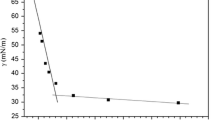Abstract
In this paper, polysiloxanes with pendant quaternary ammonium and polyether segments (EQAPS, nonionic–cationic silicone surfactant) were synthesized through hydrosilylation of poly(dimethylhydro)siloxane with allyl poly(ethylene glycol) acetic ester (M n = 540) and allyl glycidyl ether, followed by a ring-opening reaction of epoxide groups with diethyl amine and quaternization with benzyl chloride. The chemical structures of EQAPS and intermediate products were characterized by 1H-NMR and FT-IR spectra. The surface activity and thermal properties of EQAPS were studied with surface tension measurement and differential scanning calorimetry analysis, respectively. The results showed that the EQAPS had a much smaller critical micelle concentration value (118 mg/L) and lower glass-transition temperature (T g: −57 °C). The silyl-terminated polypropylene oxide waterborne emulsions, which were substantially free from organic solvent, were prepared via a phase-inversion emulsification technique using EQAPS as single emulsifier and/or poly(ethylene glycol) (\(\bar{M}\) n = 400) as cosolvent. The electrical properties of the system indicated that the phase inversion was completely accomplished. The viscosity of the emulsions with different solid contents was measured, and the results showed that the most suitable solid content was about 50 wt%. The emulsions with smaller particle size (12 μm) had better storage stability (48 days at 50 °C) and freeze–thaw stability.







Similar content being viewed by others
References
Hill RM (1999) Silicone surfactants. Marcel Dekker, New York, pp 1–48
Kawakami Y, Murthy RS, Yamashita Y (1983) Surface active properties of silicone containing polymers. Polym Bull 10:368–372
Yamahas GO, Brisdon BJ, Maxwell M et al (2001) Preparation and properties of functionalized polyorganosiloxanes. J Appl Polym Sci 82:808–817
Li J, Zhang Q, Wang Y et al (2012) Synthesis and properties of organosilicon quaternary salts surfactants. J Surfactants Deterg 15:339–344
Zeng X, Lu Z, Liu Y (2013) Synthesis and solution properties of novel sugar-based polysiloxane surfactants. J Surfactants Deterg 16:131–137
Liu JK, Wnek GE (1994) Reaction of silyl ketene acetal-functionalized polysiloxanes: synthesis of sulfonated polysiloxanes. Macromolecules 27:4080–4083
Kuo PL, Hou SS, Teng CK et al (2001) Function and performance of silicone copolymer (VI): synthesis and novel solution behavior of water-soluble polysiloxanes with different hydrophiles. Colloid Polym Sci 279:286–291
Snow SA, Fenton WN, Owen MJ (1990) Synthesis and characterization of zwitterionic silicone sulfobetaine surfactants. Langmuir 6:385–391
Subramani S, Lee JM, Lee JY (2007) Synthesis and properties of room temperature curable trimethoxysilane-terminated polyurethane and their dispersions. Polym Adv Technol 18:601–609
Wang L, Shen Y, Lai X et al (2011) Synthesis and properties of crosslinked waterborne polyurethane. J Polym Res 18:469–476
Hou Z, Qu W, Kan C (2015) Synthesis and properties of triethoxysilane-terminated anionic polyurethane and its waterborne dispersions. J Polym Res 22:111–119
Hou Z, Kan C (2015) Polysiloxanes with quaternary ammonium groups for SPPO aqueous emulsions. J Surfactants Deterg 18:517–522
Kojima S, Watanabe Y (1993) Development of high performance, waterborne coatings. Part I: emulsification of epoxy resin. Polym Eng Sci 33:253–259
Bayrak Y, Iscan M (2004) Phase inversion temperatures of triton X-100/1-butanol/hydrocarbon/water systems. J Surfactants Deterg 7:363–366
Wagner R, Wu Y, Gzichocki G et al (1999) Silicon-modified surfactants and wetting: II. Temperature-dependent spreading behaviour of oligoethylene glycol derivatives of heptamethyltrisiloxane. Appl Organomet Chem 13:201–208
Wagner R, Wu Y, Berlepsch HV et al. (1999) Silicon-modified surfactants and wetting: IV. The spreading behaviour of trimethylsilane surfactants on energetically different solid surfaces. Appl Organomet Chem 13:845–855
Vaidya AA, Kumar VG (1999) Synthesis and aggregation behavior of olefinic quaternary amino siloxanes. J Macromol Sci Chem A 36:587–603
Chen H, Zhu B (2014) A new anionic oxalamide lauryl succinate sodium sulfonate gemini surfactant: microwave-assisted synthesis and surface activities. J Surfactants Deterg 17:937–942
Kim DW, Noh ST, Jo BW (2006) Effect of salt and pH on surface active properties of comb rake-type polysiloxane surfactants. Colloids Surf A Physicochem Eng Asp 287:106–116
Yang Z, Xu Y, Zhao D et al (2000) Preparation of waterborne dispersions of epoxy resin by the phase-inversion emulsification technique. I. Experimental study on the phase-inversion process. Colloid Polym Sci 278:1164–1171
Acknowledgments
This work was supported by the Shandong Provincial Natural Science Foundation, China (No. ZR2013EMM004) and Jinan City University and Institutes Independent Innovation Planning Project, China (No. 201402044).
Author information
Authors and Affiliations
Corresponding author
About this article
Cite this article
Hou, Z., Yang, B., Zhang, D. et al. Polysiloxanes with Quaternary Ammonium and Polyether Groups for Silyl-Terminated Polypropylene Oxide Waterborne Emulsions. J Surfact Deterg 19, 739–745 (2016). https://doi.org/10.1007/s11743-016-1825-8
Received:
Accepted:
Published:
Issue Date:
DOI: https://doi.org/10.1007/s11743-016-1825-8




